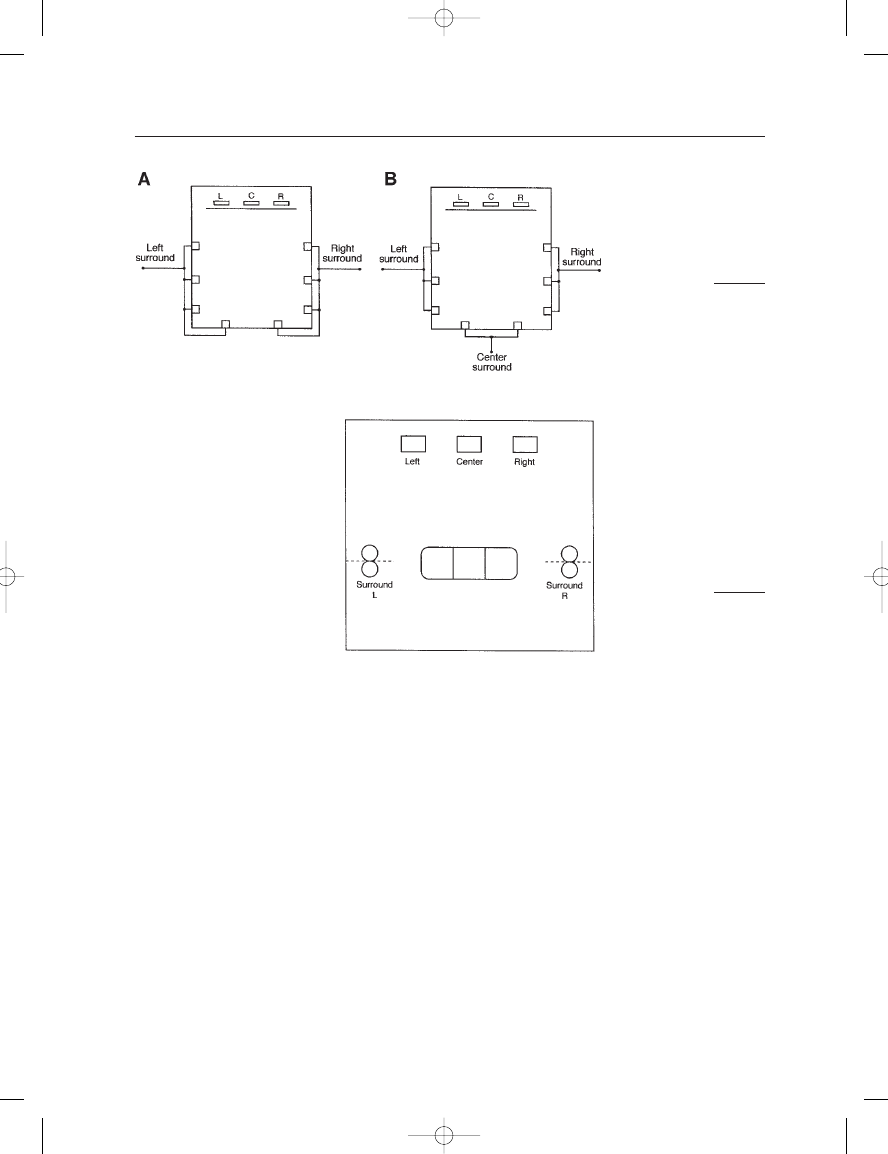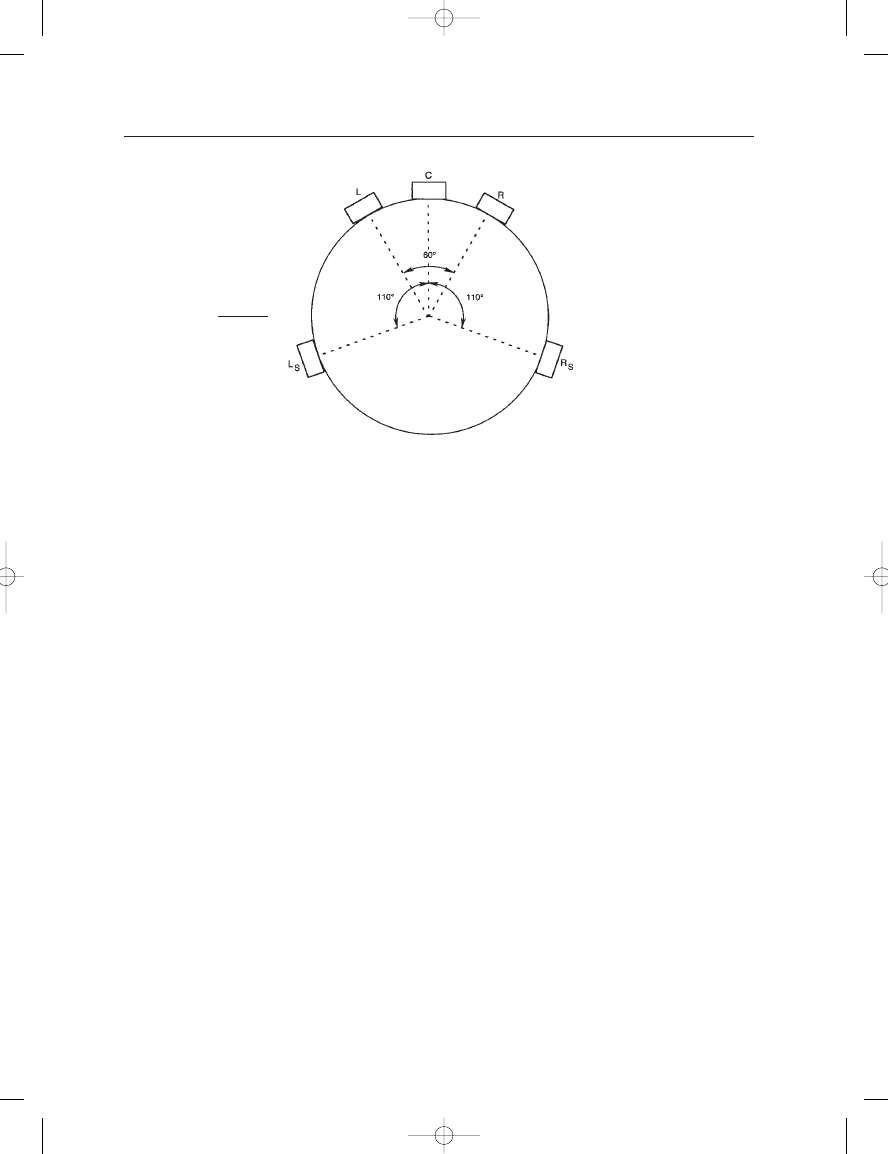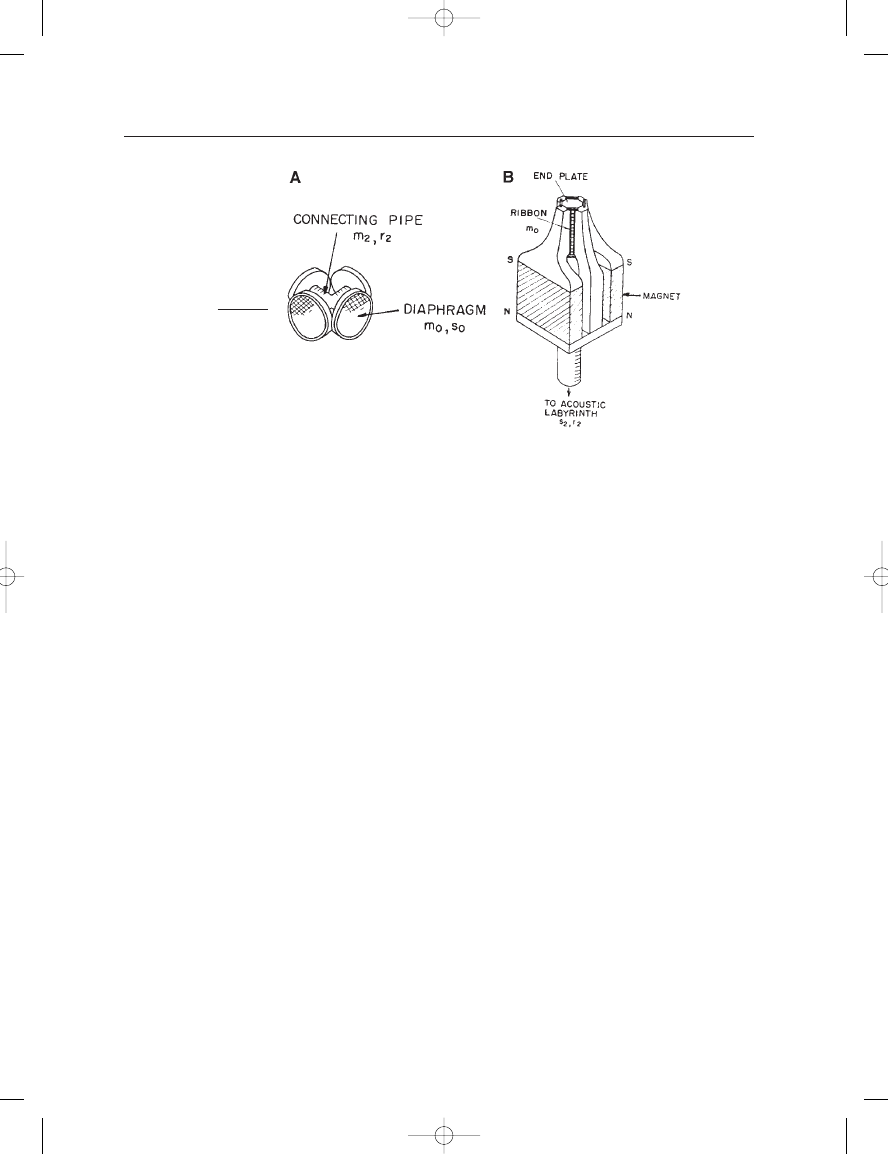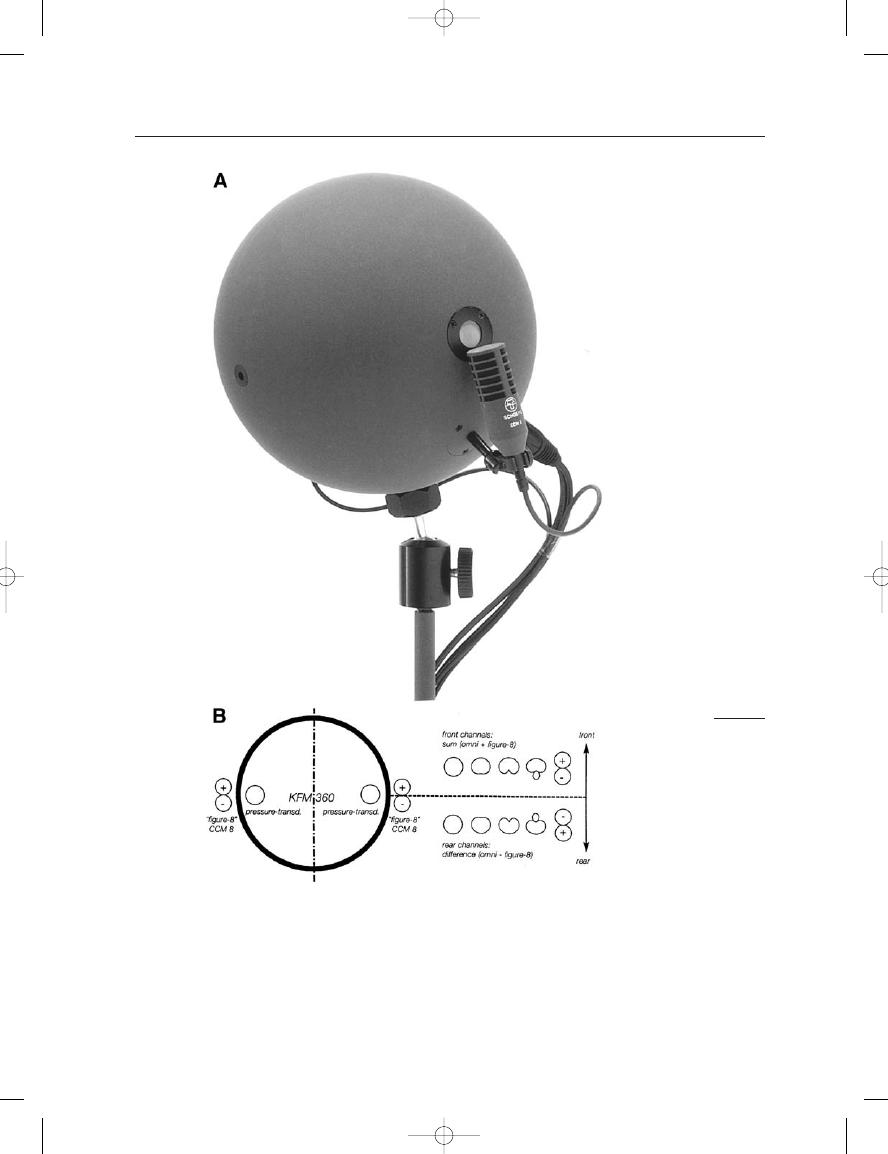ВУЗ: Казахская Национальная Академия Искусств им. Т. Жургенова
Категория: Книга
Дисциплина: Не указана
Добавлен: 03.02.2019
Просмотров: 17282
Скачиваний: 51

It is difficult to transport the complexity of the motion picture
approach into the home environment, and more often than not, only a
pair of loudspeakers will be used to convey a sense of surround envel-
opment for on-screen effects. A typical home theater loudspeaker array
is shown in Figure 15–6. Here, dipole loudspeakers are used for the
surround channels. The dipole loudspeaker exhibits deep nulls in its
response at angles of 90
relative to forward and rear axes, and the side
null axes are aimed at the primary listening area. The result is that the
signal from the surround channels reaches the listeners primarily by way
of room reflections and is thus less likely to call attention to itself as com-
ing from distinct positions left and right of the listeners.
Dipole loudspeakers work well for surround music channels that are
primarily reverberant in their signal content. For more generalized music
presentation, the playback format shown in Figure 15–7 is recom-
mended. This figure illustrates the standard loudspeaker configuration
recommended by the ITU (International Telecommunications Union,
1994) for the setup of listening environments for the mixing of surround
sound programs for professional activities. While these recommendations
THE MICROPHONE BOOK
248
FIGURE 15–5
Loudspeakers in the motion
picture theater: using two
surround channels (A);
using three surround
channels (B).
FIGURE 15–6
Typical home theater
surround sound
loudspeaker locations.
Earg_15.qxd 14/9/04 2:56 PM Page 248

are appropriate for surround sound presentation, it is felt by many
workers in the field that the left and right front loudspeakers, with their
target spacing of 60
, may be too widely spaced for normal stereo listening
in the home.
In laying out a surround sound mix, the three frontal channels are
important in defining and positioning of primary musical elements. Our
hearing capability can lock on elements in the frontal soundstage and
identify their lateral position within a few degrees. This acuity is far
more stable with three frontal channels than it is using phantom images
in two-channel stereo, and it substantially enlarges the effective seating
area for all listeners.
While we are very aware of sounds originating from the sides and
rear, we have considerable difficulty in determining their actual posi-
tions. Sounds arriving from the sides are generally highly uncorrelated at
the ears and as such contribute to a sense of ambience in the reproduced
recording. Because of the ear’s difficulty in assigning specific directional-
ity at the sides, a single pair of channels can handle the needs for con-
veying ambience very well, especially if the loudspeakers are arrayed in
large quantities, as in the motion picture theater, or as diffuse-radiating
dipole loudspeakers. Thus, the obvious use of the surround channels in
classical music is in conveying early reflections and reverberant sound in
the recording space. Note that the rear loudspeakers in the ITU configu-
ration are positioned more to the sides than the back. In this position
they can convincingly deliver both early reflections and reverberant
sound.
Pop mixes are routinely made with secondary musical elements
panned into the surround channels; here we include such elements as
background vocals and rhythm fills. Live concerts usually fare very well
in surround sound through the combination of audience reactions and
secondary musical elements in the rear channels.
15: Surround Sound Microphone Technology
249
FIGURE 15–7
ITU recommended
reference loudspeaker
locations for surround
sound monitoring; the
nominal
110 positions
may vary between 100
and 120
.
Earg_15.qxd 14/9/04 2:56 PM Page 249

Extending the 5.1 concept to a greater degree, Holman (2000) has
suggested the 10.2 channel approach shown in Figure 15–8. The wide-
front channels are used primarily to enhance important early side reflec-
tions, which help to define the acoustical nature of a good recording
space; the center back channel ensures spatial continuity and permits
unambiguous rear imaging. The front overhead channels provide height
information which, like the front-wide channels, enhances spatiality and
adds realism to the presentation. The use of two low frequency channels
restores some of the spatial subtlety in the lower frequency range which
results from side-to-side pressure gradients at long wavelengths. Such
effects may be lacking when a single channel is used below 100 Hz.
Holman further points out that the exact positions of the added loud-
speakers are subject to a moderate amount of leeway in actual position-
ing in the playback space. In practical application of the 10.2 format, the
notion of “virtual” microphones (see Chapter 19) is useful in the gener-
ation of secondary reflected and ambient signals.
MICROPHONES AND ARRAYS FOR
STEREO-DERIVED SURROUND SOUND
While most surround sound recording is carried out using conventional
microphones and techniques, with assignment of the various signals into
the five cardinal points of a surround sound array, a number of micro-
phone designs and microphone arrays are used for recordings intended
primarily for surround presentation. Some of them are discussed below.
THE MICROPHONE BOOK
250
FIGURE 15–8
Layout of the TMH
Corporation proposed
10.2 array.
Earg_15.qxd 14/9/04 2:56 PM Page 250

COINCIDENT ARRAYS
Going back to the quadraphonic era, a number of microphones were
developed that provided for one-point pickup of sound from four direc-
tions, a concept that is still useful in certain aspects of surround sound.
Typical here is the single-point four-cardioid array developed by
Yamamoto (1975), shown in Figure 15–9, either as a group of cardioid
capacitor elements (A) or ribbon elements (B) picking up sound in the
azimuthal (horizontal) plane. In either case, the mechanical and acousti-
cal elements in the designs have been adjusted so that the target cardioid
directional characteristics of each element are maintained around the
circle with smooth transitions between adjacent pairs.
NEAR-COINCIDENT ARRAYS
The Schoeps KFM 360 spherical array
Developed by Bruck (1997), the KFM 360 produces a dual set of MS
stereo patterns, one set facing the front and the other facing the rear.
Both MS sets are attached to a sphere 18 cm in diameter, as shown in
Figure 15–10A. The pattern choices are shown at B. The user can choose
the forward patterns independently of the rear patterns, thereby altering
front-back perspectives. The microphone array is fed to the DSP-4 con-
trol unit shown in Figure 15–11A, and a signal flow diagram for the unit
is shown at B.
The gradient microphones enable this fairly small array to produce
excellent fore-aft spatial delineation, and the effect can be further height-
ened through use of the rear channel delay function. Note that the con-
trol unit produces a front-center output via the Gerzon 2-to-3 matrix
circuit (see below under Systems with Parallax).
15: Surround Sound Microphone Technology
251
FIGURE 15–9
Single-point quadraphonic
microphones: using
capacitor elements (A);
using ribbon elements (B).
(Figure courtesy of Journal
of the Audio Engineering
Society.)
Earg_15.qxd 14/9/04 2:56 PM Page 251

The Holophone Global Sound microphone system
This system has a set of five pressure microphone elements located on the
surface of an oval-shaped (dual radius) ellipsoid. The microphones can be
extended out a short distance from the ellipsoid for enhanced separation.
In its wireless form the system is excellent for field effects gathering.
THE MICROPHONE BOOK
252
FIGURE 15–10
The Schoeps KFM 360
four-microphone array:
photo of left side of unit
showing imbedded pressure
microphone and external
gradient microphone (A);
front and rear pattern
selection for the KFM 360
(B). (Photo courtesy of
Schoeps.)
Earg_15.qxd 14/9/04 2:56 PM Page 252